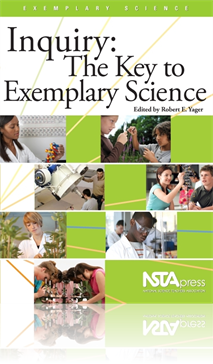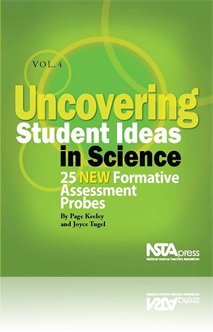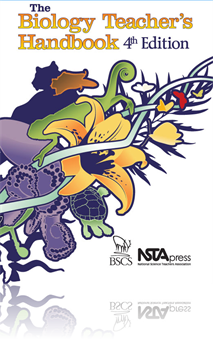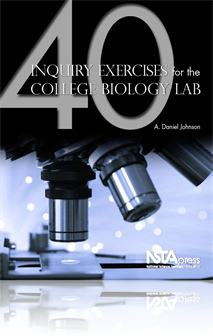All Book Chapters
Book Chapter
Science Is Not a Spectator Sport: Three Principles From 15 years of Project <em>Dragonfly</em>
Project Dragonfly at Miami University was founded on the premise that the most powerful way to engage children in learning is to celebrate their voices, to invite them into the community of discovery, and to allow them to see themselves as agents of ...
Book Chapter
Student Inquiry and Research: Developing Students’ Authentic Inquiry Skills
In the 2005 NSTA monograph Exemplary Science in Grades 9–12: Standards-Based Success Stories, the authors present and discussed student inquiry at the Illinois Mathematics and Science Academy (IMSA) (Scheppler et al. 2005). This monograph focused o...
Book Chapter
From Wyoming to Florida, They Ask, “Why Wasn’t I Taught This Way?”
As educators recognize the power of inquiry in the classroom, the Conceptual Change Model (CCM) is gaining popularity across the country. Those who are using CCM are reporting that students are highly engaged and excited about learning and they are g...
Book Chapter
Student Outreach Initiative: Sowing the Seeds of Future Success
This chapter features the Student Outreach Initiative project developed as a collaborative research community between USDA/Agricultural Research Service/Southern Plains Area (ARS/SPA) laboratories and their local communities and schools (grades 4–1...
Book Chapter
Developing Inquiry Skills Along a Teacher Professional Continuum
The setting for this chapter is Bradley University—a midsize, private, comprehensive university in a Midwestern community of approximately a quarter million people. In the past decade, new faculty members have brought philosophies of teaching that ...
Book Chapter
Promoting Inquiry With Preservice Elementary Teachers Through a Science Content Course
Inquiry science teaching is effective at all levels, from elementary classes to higher education. It is important, therefore, that preservice education majors who will be teaching science understand the differences between inquiry instruction and ins...
Book Chapter
Developing a Relationship With Science Through Authentic Inquiry
In this chapter, the authors first describe the theoretical framework they have developed for understanding and developing their work as teachers. They start by articulating their own understanding of teaching and learning. Following this discussion,...
Book Chapter
The purpose of this assessment probe is to elicit students' ideas about systems. The probe is designed to find out whether students can recognize that things with parts that interact or influence each other are systems....
Book Chapter
The purpose of this assessment probe is to elicit students' ideas about the digestive system. The probe is designed to find out whether students realize a main function of the digestive system is to break food down into molecules that can be used by ...
Book Chapter
The purpose of this assessment probe is to elicit students' ideas about the distribution of land, oceans, freshwater, and ice. The probe is designed to find out whether students realize that most of the Earth is covered by oceans....
Book Chapter
The purpose of this assessment probe is to elicit students' ideas about light and the Moon. The probe is designed to find out what students think is the source of a full Moon's light....
Book Chapter
The purpose of this assessment probe is to elicit students' ideas about eclipses. The probe is designed to find out what students think causes a lunar eclipse....
Book Chapter
The purpose of this assessment probe is to elicit students' ideas about weight and pressure. The probe is designed to determine whether students think their weight changes when the force exerted per unit area (pressure) on a scale changes....
Book Chapter
The purpose of this assessment probe is to elicit students' ideas about magnetism. The probe is specifically designed to determine whether students believe air is necessary for magnets to work....
Book Chapter
The purpose of this assessment probe is to elicit students' ideas about dissolving. The probe is designed to find out what students think happens to sugar when it dissolves in water....
Book Chapter
The purpose of this assessment probe is to elicit students' ideas about food, transformation of matter, growth and development, conservation of mass, and systems. The concepts underlying this probe are complex. It is not important that students know ...
Book Chapter
The purpose of this assessment probe is to elicit students' ideas about biological adaptation. The probe is designed to find out if students think animals intentionally adapt to a change in their environment....
Book Chapter
The purpose of this assessment probe is to elicit students' ideas about crystalline solids.The probe is specifically designed to determine how students think atoms are arranged and move in a crystalline lattice....
Book Chapter
The purpose of this assessment probe is to elicit students' ideas about biological evolution. The probe is designed to find out if students distinguish the theory of biological evolution from ideas about the origin of life and the mechanism for biolo...
Book Chapter
The purpose of this assessment probe is to elicit students' ideas about the effect of solar radiation on Earth's temperature. The probe is designed to find out whether students realize the Earth continues to cool after sundown and up to sunrise until...
Book Chapter
The purpose of this assessment probe is to elicit students' ideas about conservation of matter during combustion. The probe is designed to find out if students think the mass changes as paper burns inside a closed system....
Book Chapter
The purpose of this assessment probe is to elicit students' ideas about temperature in the context of phases of matter. The probe is designed to find out if students recognize that the temperature of a substance does not change when two phases are pr...
Book Chapter
If students develop an understanding of how science inquiry is done and how it contributes to understanding the natural world, they will be better prepared to analyze and interpret information throughout their lives. Merely telling students how knowl...
Book Chapter
Ethology—the study of animal behavior—combines the observational skills of a natural historian with modern insights from ecologists, geneticists, and especially evolutionary biologists. In this unit, students discover more of the behavior reperto...
Book Chapter
The ultimate function of most physiological processes is to help organisms maintain overall homeostasis, while letting them adapt to changes in internal and external environments. In this unit, heart rate is the model for studying homeostasis. The st...
Book Chapter
Students will use weight potometry to estimate the basal rate of transpiration for bean plants. For the exercise, they will estimate the soil salinity necessary to stop transpiration by mung bean seedlings. Subsequently, students will have the opport...
Book Chapter
Metabolism and Oxygen Consumption
In this unit, students first conduct an experiment to determine if there is a relationship between environmental temperature and rate of metabolism in crayfish (Orconectes). Students also look at whether there is any effect of body size on specific m...
Book Chapter
In this unit, students compare allocation strategies among plant species and within a species under different abiotic conditions. Students will quantify how seedlings of several common crop plants allocate their carbon and nitrogen resources by measu...
Book Chapter
In this unit, students explore how biotic and abiotic factors affect population growth. They explore the effects of competition on growth of different species of molds. Students have actively growing cultures with which to make an inoculation mix of ...
Book Chapter
Measuring Biological Diversity
Biological diversity is a hallmark of life on Earth. In this unit, students estimate biological diversity in two different aquatic ecosystems. They collect water and bottom detritus from two locations and make field notes about the locations. Each wo...
Book Chapter
Designing Scientific Experiments
In this unit, students learn about designing sound, testable hypotheses and experiments. A testable hypotheses is one that is stated in a way that makes predictions that can be tested. The goal of the unit is for students to unravel a simple biologic...
Book Chapter
In a typical Mendelian genetics lab, students cross flies or other organisms of known genotypes, score phenotypes of the offspring, and determine if their results are significantly different from expected phenotype ratios. For this unit, the traditio...
Book Chapter
In this unit, students will isolate DNA suitable for sequencing and other analyses. Students use bioinformatics software to find differences between normal and mutant DNA sequences, then use DNA restriction mapping to confirm the differences. In orde...
Book Chapter
Enzymes are specified proteins that catalyze chemical reactions in biological systems without being permanently changed or used up. This unit was developed to help students gain a more functional, intuitive understanding of how enzymes work, what fac...
Book Chapter
This unit focuses on properties and functions of enzymes. Students will discover for themselves how enzyme concentration, environmental conditions, and potential inhibitors affect enzymes. The unit is more challenging for students as they must apply ...
Book Chapter
The process of photosynthesis is the key to life on Earth. In this unit, students will learn to make an enriched chloroplast preparation from spinach leaves. They will measure relative redox activity by mixing them with DCIP, an indicator dye that c...
Book Chapter
In this unit, students look at the signal transduction pathways that let cells sense and respond to their external and internal environments. The model organism is the free-living unicellular algae, Chlamydomonas reinhardtii. Chlamydomonas is extrem...
Book Chapter
In this unit, students explore hormonal regulation of insect development. Students look at fruit flies—Drosophila melanogaster—in various stages in their life cycles and expose larval flies to a range of concentrations of juvenile hormone. Final...
Book Chapter
In this unit, students learn about the neuromuscular system by dissecting the sciatic nerve and gastrocnemius muscle from the leg of a frog and connecting them to a force transduction apparatus. Then they learn to record myograms from the muscle prep...
Book Chapter
A Brief Introduction to Inquiry
When the term inquiry comes up in conversations about science curriculum reform and improvement, it usually is shorthand for inquiry-based learning and, by extension, inquiry-based instruction. But, what exactly is meant by inquiry-based learning? In...






